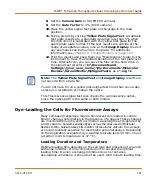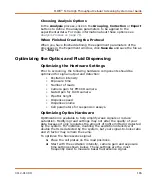
Calibration and Signal Test
154
0112-0109 H
Running the Yellow Plate Signal Test
To run a Yellow Plate Signal Test:
1.
Select
Yellow Plate Signal Test
from the
Instrument/Manual Operation
menu or click on the
appropriate button.
2.
Depending on the camera type installed in your instrument, the
settings will vary for the Fluorescence signal test. We
recommend using the default values set in your software.
3.
Place the signal test plate on the stage in the read position.
4.
Take a picture by clicking
Test Signal
. Acceptable test plate
results are a standard deviation less than 5% when the
instrument is calibrated with the yellow test plate for the
appropriate plate format. If the test results are outside of the
range of acceptable values, look at the
Image Display
to see if
any anomalies can be found on the plate. For additional
information see
Chapter 9: Troubleshooting on page 197
5.
Print the results and keep them in a maintenance folder by the
instrument to track the standard deviation of the test plate over
time. Alternatively, you can save the files on the hard drive.
The standard deviation should be less than 5% if the flat field
calibration was performed using the Flat Field Calibration Plate of the
respective plate format (96, 384 or 1536).
Running a Plate Prior to an Experiment
This option is only recommended for Fluorescence experiments.
Run the
Protocol Signal Test
of your cell plate using the camera
parameters in your protocol as described in
Depending on the range of values obtained, you may choose either to
run the experiment or alter the
Excitation Intensity, Exposure
Time
,
Camera Gain,
or
Camera Gate
. A suggested starting point for
a calcium mobilization assay is 200–1,500 counts.
Settings may be changed in the
Protocol Signal Test
. Depending on
the installed camera and the read mode, different parameters are
available for adjusting the signal strength. Please see
for the exact description of each of these parameters.
Note:
The
Yellow Plate Signal Test
and
Image Display
results are
not saved within a data file. You do not have to run a signal test more
than once a day.
Summary of Contents for FLIPR Tetra
Page 1: ...FLIPR Tetra High Throughput Cellular Screening System User Guide 0112 0109 H December 2011...
Page 12: ...Contents 12 0112 0109 H...
Page 16: ...System Overview 16 0112 0109 H...
Page 40: ...System Hardware Features 40 0112 0109 H...
Page 148: ...Exchanging Hardware 148 0112 0109 H...
Page 156: ...Calibration and Signal Test 156 0112 0109 H...
Page 196: ...Running an Experiment 196 0112 0109 H...
Page 232: ...Robotic Integration 232 0112 0109 H The following drawings illustrate these requirements...
Page 282: ...Data Processing Algorithms 282 0112 0109 H...
Page 294: ...Consumables and Accessories 294 0112 0109 H...
Page 298: ...Using AquaMax Sterilant 298 0112 0109 H...
Page 302: ...Electromagnetic Compatibility EMC 302 0112 0109 H...
















































